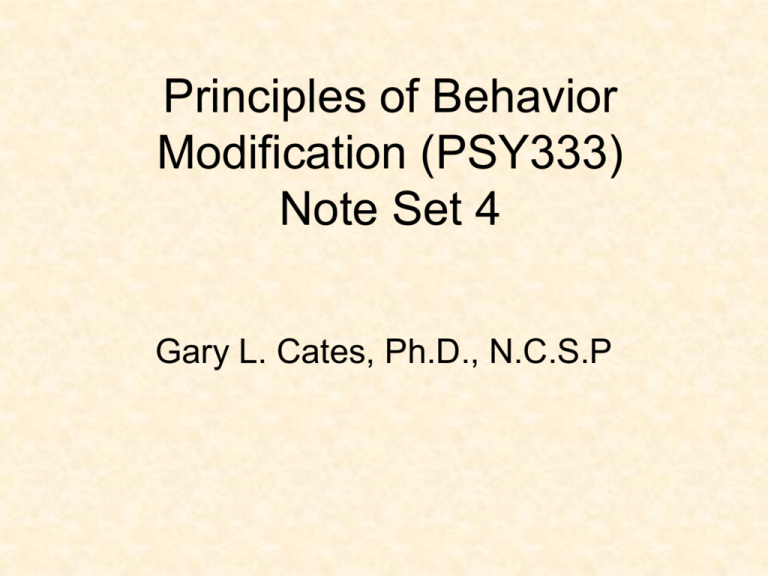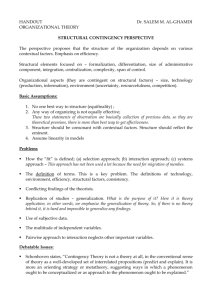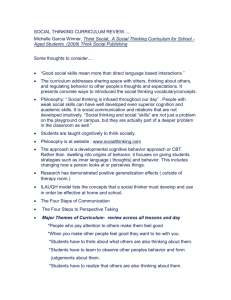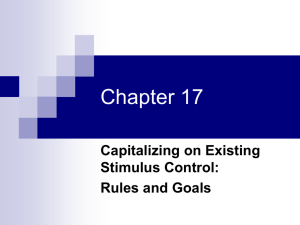Principles of Behavior Modification (PSY333)
advertisement

Principles of Behavior Modification (PSY333) Note Set 4 Gary L. Cates, Ph.D., N.C.S.P Maintenance • Continuing performance after it was first established • Behavior Trap: Built in reinforcers take control of artificially delivered reinforcers • Perpetual Performance Contracting does not exist Generalization Part 1 Stimulus Generalization – When behavior becomes more probable in presence of one stimulus or situation as a result of having been reinforced in the presence of another stimulus. e. g. Using your money at McDonalds is very similar as using your money at Wendy’s How to get generalization to occur E.g. mathematics: Balancing checkbook • Train in the target situation: Balance Checkbook in store • Vary Training Conditions: Extraneous stimuli present • Program Common Stimuli: the checkbook itself (common learning materials). • Train sufficient stimulus exemplars: several different stores, items, costs etc. Your turn • Each of you write down an example of stimulus generalization that has occurred with you. Generalization Part 2 Response Generalization • Behavior becomes more probable in the presence of a stimulus as a • result of another behavior that was reinforced in the presences of that stimulus√ Do not confuse with stimulus generalization e.g. Behavioral Momentum: Compliance high p e.g. Computer vs. worksheet vs. flashcards How to get response generalization to occur • Train sufficient response exemplars: e.g. Plurals • Vary the acceptable responses during training: – Only reinforce less probable responses • √ Make use of rules to speed it up Your turn • Each of you write down an example of how response generalization has occurred with your behavior. Rules • Nothing more than SD’s and Sw’s – Cues that certain behaviors will pay off or punish Contingency Shaped Behavior • Behavior mediated by direct acting contingencies in the environment • Immediate consequences • Trial and learning often associated with contingency shaped behavior √ This is what most people believe behavioral people are interested in Rule-Governed Behavior • Behavior controlled by the statement of a rule • Don’t touch that hot pan or you will get burned (SW) • Use our credit card and you will earn money/points back (SD) Why we have difficulty following rules 1. Contact with rules is too small 2. Consequences are usually cumulative (not immediate) 3. Contact with rules is too improbable. 4. Rule description is too vague 5. Deadlines are not effectively established Procrastination: Example of Rule following • Putting off until tomorrow what you could/should do today. • Supplement hard rules with easy rules • induce the establishing operation daily (e.g. anxiety) with a deadline with a sizeable outcome that is less-cumulative (i.e., more immediate). Theory of Rule Governed Behavior • Both direct and indirect acting contingencies in place. The rule is an indirect acting contingency that serves to induce an aversive establishing operation (Anxiety, fear etc). To escape such direct contingency we engage in the behavior maintained by earlier learning of how to escape aversive contingencies. Three contingency model of performance management • Ineffective natural contingency: (rule that does not produce strong responses) • If you study daily you will get a good grade – Behavior: You study daily – Consequences: You get a good grade Three contingency model of performance management • Indirect-Acting Contingency (the rule itself) • If you do not study daily you loose five dollars – Behavior: You study Daily – Consequence: You get a good grade and do not loose five dollars Three contingency model of performance management • Direct-Acting Contingency (the feeling associated with the rule) • You have anxiety about loosing five dollars – You study daily – You do not loose five dollars and you get a good grade and – you escape the anxiety When are rules helpful? – When you want rapid Behavior change – When consequences are too delayed – When you want to maintain behavior for which natural reinforcers are highly intermittent – To guard against immediate severe punishment Setting Goals • • • • • • • • • • Be specific Include mastery criteria (development of skills) Identify circumstances Realistic and challenging Public better than private Set deadline Goal setting plus feedback better than goal setting alone Must be a commitment to goal (i.e. no one changes unless they want to change). Break long term goals into several shorter goals (Task analysis) Monitor progress continuously Writing Goals • I’m going to do more exercise. • I’m going to do two more exercises when I work out. • I’m going to include sit-ups and push-ups during my work-out routine. • I’m going to include 3 sets of 20 sit-ups and 3 sets of 20 push-ups during my workout routine three times per week. Token Economies Token: A conditioned reinforcer that can be turned in for backup reinforcers • Can be given immediately • Makes group administration of reinforcers easier How to set up a token economy • • • Take baseline data on the target responses Select backup reinforcers and how to distribute them Select token type: Checks, stars, bucks, stamps etc. – Not easily counterfeited! How to implement a token economy • • • • Keep data: Must construct data sheets Consistency in delivery: Specific agent for specific behavior Number/Frequency of R+: Continuous at first and fade to some intermittent schedule. managing backup reinforcers: How often? How to implement a token economy • • • • Possible punishment contingencies? Supervision of staff: Treatment integrity Handling problems: Anticipation is the best approach Make a manual or rule booklet The most important things to remember • Wean individuals from the token economy: Value, or frequency • Transfer from token to social reinforcement • Gradually transfer control to client to selfreinforce/monitor Self-Control Causes of Self-Control Problems of Behavioral Excesses • Immediate reinforcers versus delayed punishers for a behavior • Immediate Reinforcers Versus Cumulatively significant punishers for a behavior Causes of Self Control Problems of behavioral deficiencies 1. Immediate small punishers for a behavior versus reinforcers that are cumulatively significant 2. Immediate small punishers for a behavior versus immediate but highly improbable major punisher if the behavior does not occur 3. Immediate small punisher for a behavior versus delayed major punisher if the behavior does not occur. Small Group Activity • What appears to be the problem with people: – Wearing helmets on bikes – Quitting smoking – Not overeating – Not exercising enough A Model for Self-Control • • • • • • • Specify problem behavior Set Goals Make a commitment to change Take data Analyze causes Design and implement program Prevent Relapses and make your gains last Small group activity • What can you do to help people: – Not overeat – Quit smoking – Wear bike helmets – Exercise more frequently Causes of relapse • • • • • • • • Avoidable setback situations Unavoidable setback situations Overreaction to occasional setbacks Counterproductive self-talk Fuzzy Target Behavior Long-term target behavior Trying too much too soon Failure to incorporate everyday rewards into your program • Failure to plan follow-up checks Considering relapse • How would you now modify your treatment protocol for self help programs in: – Exercising – Overeating – Smoking – Wearing bike helmets A Behavioral Contract • • • • Ensures agreement by all parties Provides method of monitoring goal attainment and progress Provides good estimate of what is involved with the program Provides outlet for conditioned commitment (signing contract) Components of Behavioral Contract • • • • • • Names of parties involved Operationally defined behavior Criteria to be met Consequences for criteria Dates/times/settings Methods for renegotiation Modeling, Guidance, and Situational Inducement Modeling • Presenting a sample of a behavior for a person to copy • Factors that affect modeling – More likely to imitate behavior of people most like you – Seeing a model earn a reinforcer – The more models (exemplars) the better – Provide rules as well Physical Guidance Method to teach imitation – Generalized imitation results when individual can imitate after being able to imitate a new response on first trial without reinforcement. • Client must be accepting of this being touched * Not restrictive procedure: Get permission – Sequence when the procedure is a complex chain – Remember to fade the guided prompts Situational Inducement – Rearranging surroundings – Move to new location – Relocate people: Move away or move to the environment – Changing the time of the activity • * To use this effectively, you need to do some brainstorming about possible antecedents (i.e. environmental arrangements) that could contribute to the behavior. Motivation All behavior is goal directed behavior What are the motives of behavior? • Attention: To get something • Escape: To get out of something • Sensory stimulation/Automatic reinforcement: To get something • Tangible reinforcement: To get something Let’s tie the principles of Behavior Modification Together Phobias • How might you define them? • What causes them? • How might you treat them? Anxiety • How might you define it? • What causes it? How does it start? Depression • What is the cause? How does it start? • How might you define it? • How might you treat it? Sadomasochism • How might you define it? • What causes it? How does it start? • How might you treat it? Clinical Behavior Therapy Cognitive Behavior Modification Cognition: belief, thought, expectancy, attitude, or perception • Assumption 1: People respond to events in terms of their perceived significance. • Assumption 2: Cognitive deficiencies cause emotional disorders. • √ Goal: Change cognition to make better adjusted person Method 1: Cognitive Restructuring • Substituting rational thoughts and appraisal of information for irrational or dysfunctional thinking. • Ellis: Rational Emotive Therapy (Later REBT) • Beck: Cognitive Therapy – Dichotomous Thinking: Absolute terms – Arbitrary Inference: Faulty conclusions – Overgeneralization: One failure means failure in general – Magnification: Exaggeration Method 2: Self-instructional Coping methods • • • • Identify internal stimuli that are stress related Use them as SD’s to engage in appropriate self talk Appropriate self talk through a set of things to do to relax Positive self reinforcing statements after positive self talk Method 3: Problem-Solving Methods • General orientation: Be systematic not impulsive • Problem Definition: Be specific • Generation of alternatives: Brainstorm solutions • Decision making: Evaluate the pros and cons to each alternative and pick the best one. • Verification: Keep track of progress (data) Empirical Evaluation of Ellis • Reducing self talk: 46% • Reducing emotional distress: 27% • Gossette and O’Brien (1992) √ Effects probably due to homework assignments, not the challenge of cognition. Let’s Add Cognitive Restructuring! • Let’s not! – 83% of research suggests it adds nothing! – Helpful for social anxiety only Empirical Evaluation of Beck • No better than a placebo (placebo may be effective!) [NIMH, 1989] • - 55% BT, 52% IPT, 46% CT, 34% BDPT (Agency for health care policy and research, 1994) Behavioral vs. Cognitive • 83% of pure cognitive had no added benefit. √ Cognitive good for social-anxiety and phobia Two Points • Cognitive techniques rely on rulegoverned behavior • Rules control behavior only when linked to environmental contingencies Areas of Clinical Behavior Therapy • Agoraphobia: In vivo exposure (group or individual) – Cognitive restructuring does not add anything • OCD: In vivo exposure (65-75%) – Cognitive (imagining) led by therapist adds to effectiveness. • Stress: Relaxation techniques and exercise • Depression: Exercise is gaining a lot of momentum • placebo > no Tx and = to cognitive therapy • 30-60 minutes 3 times per week Areas of Clinical Behavior Therapy • Alcohol Problems: – – – – – – Most successful programs use behavioral components such as: Decreasing reinforcing properties of alcohol Teaching new skills Strategies to prevent relapse Contingency management SOCIAL SUPPORT IMPORTANT! DRA? √ Tx good for problem drinkers not as effective for alcoholics • Obesity – Self-monitoring, stimulus control, changing eating behavior, behavioral contracts Areas of Clinical Behavior Therapy • Marital Distress – Instigation of positive exchanges – Communication Training – Problem Solving Training • Habit Disorders – Habit reversal (Azrin & Nunn, 1973) History Respondent Conditioning • 1904 Pavlov wins Noble Prize in Medicine • 1913 J.B. Watson writes Behaviorists Manifesto • 1916 Little Albert • 19 43 Clark Hull: Operant & Respondent • 1958 Wolpe: reciprocal inhibition Operant Conditioning • 1938 Behavior of Organisms • 1950 Keller & Schoenfield: Principles of Psychology • 1953 Science of Human Behavior – Testing out: Sugar-milk, mmm-hmmm, Jellybeans – Allyn & Michael (1959). • 1965 Ullmann & Krasner: 1st bmod book • 1982 Iwata (Functional Analysis) Terms • Behavior Modification: The large over arching term to describe behavior principles being used to modify behavior • Behavior Therapy: Pavlov-wople orientation with cognitive focus • Behavior analysis: Operant orientation (Function) Ethics in Behavior Modification Ethical Issues for Human Services • Have goals of treatment been adequately considered? • Has choice of treatment methods been adequately considered? • Clients participation voluntary? • Subordinate client interests considered? • Adequacy of treatment been evaluated? • Confidentiality protected? • Referrals when necessary? • Therapist Qualified? Careers in Behavior Modification So you want to be a behavior modifier/analyst huh? Schools in behavior analysis • http://programs.gradschools.com/usa/appli ed_behavior_analysis.html • http://www.abainternational.org/sub/behavi orfield/education/accreditation/index.asp • Behavioral School Psychology – Syracuse, MSU, USM, UN-L, UO, ISU? Interesting Jobs • Most you need a masters degree – Certified as behavior analyst & Collect 3rd party pay • B.S. Marcus Institute, Kennedy Krieger, • Ph.D. – Licensed Psychologist





